

Hertzsprung–Russell diagram. An HR diagram showing many well known stars in the Milky Way galaxy.
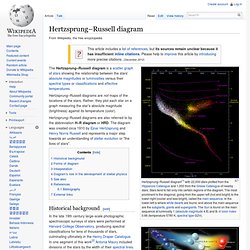
If A Primordial Black Hole Hits The Sun... Astronomers have so far discovered two types of black hole: supermassive ones at the centre of galaxies and stellar-mass black holes, which form when giant stars die.

But there’s no reason why black holes of any size cannot form. In fact, many astronomers think that the variations in density in the early universe would have led to the natural formation of relatively small black holes. The smallest of these ought to have evaporated by now. But black holes with the mass of an asteroid, say, ought to be floating round as I write. They may even make up the mysterious dark matter that fills the universe. Various theorists have suggested that we could spot primordial black holes by phenomena such as lensing effects as they pass in front of distant stars or by the gamma ray bursts they create as they flicker out of existence. Such an event wouldn’t be as catastrophic as it sounds. That should generate a scramble. V.massive black holes already existed - 750 mil yrs after BB. Scientists discovered the universe’s earliest black holes and, in the process, added support to a theory that the cosmological objects developed in tandem with their host galaxies.
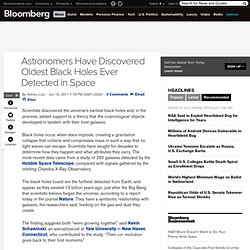
Black holes occur when stars implode, creating a gravitation collapse that collects and compresses mass in such a way that no light waves can escape. Scientists have sought for decades to determine how they happen and what attributes they carry. The most-recent data came from a study of 250 galaxies detected by the Hubble Space Telescope, compared with signals gathered by the orbiting Chandra X-Ray Observatory. Astronomers discover earliest black holes at dawn of universe. Astronomers have been peering farther and farther into space, and back in time, using the world's most powerful telescopes to detect galaxies billions of light years away that existed when the universe was just a fraction of its current age.
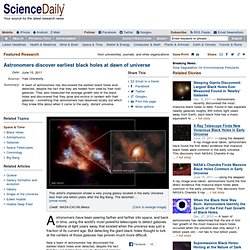
Hungry Black Holes Lurk at Edge of the Universe. 13 billion light-years away, at the very edge of our observable universe, supermassive black holes lurk inside their galactic hosts, feeding.
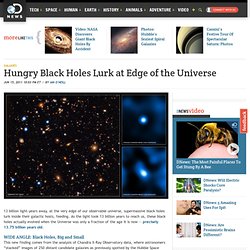
As the light took 13 billion years to reach us, these black holes actually evolved when the Universe was only a fraction of the age it is now — precisely 13.75 billion years old. WIDE ANGLE: Black Holes, Big and Small This new finding comes from the analysis of Chandra X-Ray Observatory data, where astronomers “stacked” images of 250 distant candidate galaxies as previously spotted by the Hubble Space Telescope. The stacking process allowed extremely faint X-ray emissions from the centers of the galaxies to multiply, highlighting the location of the black holes living in their cores, feeding off dust, gas and unfortunate stars. This is a significant finding as black holes are known to reside inside local (young) galaxies like our own, but little was known about ancient galaxies.
Astronomers Discover Earliest Black Holes at Dawn of Universe. Now a team of astronomers has discovered the earliest black holes ever detected, despite the fact that they are hidden from view by their host galaxies. ) The astronomers focused on more than 250 galaxies, which had previously been detected by the Hubble Space Telescope and which they thought were good candidates for harboring black holes at their centers.

Theorists, including Yale cosmologist Priyamvada Natarajan, used the observations to determine that even these earliest black holes appear to grow and evolve along with their host galaxies, which is similar to what astronomers have observed in the nearby universe. Read Full Story » Keywords. Most distant black holes ever found reveal secrets - Technology & Science. The new study used images from the Chandra X-Ray Observatory, a space telescope that orbits the Earth, to measure the growth rates of the black holes at the centre of galaxies that existed as early as 700 million years after the Big Bang, such as the black hole shown in this artist's drawing.
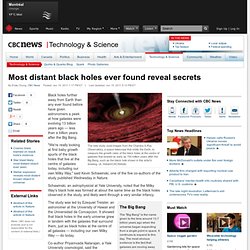
(A. Hobart/CXC/NASA) Black holes further away from Earth than any ever found before have given astronomers a peek at how galaxies were evolving 13 billion years ago — less than a billion years after the Big Bang. Most Dangerous Places (The Universe 1) part 48 of 60. How the Sun Shines. By John N.

Bahcall* What makes the sun shine? How does the sun produce the vast amount of energy necessary to support life on earth? These questions challenged scientists for a hundred and fifty years, beginning in the middle of the nineteenth century. Theoretical physicists battled geologists and evolutionary biologists in a heated controversy over who had the correct answer. Why was there so much fuss about this scientific puzzle? Youngest millisecond pulsar... Millisecond pulsar in spin mode. The gamma radiation of a rapidly rotating neutron star casts doubt on the models of the origin of such objects November 03, 2011 Astronomers have tracked down the first gamma-ray pulsar in a globular cluster of stars.
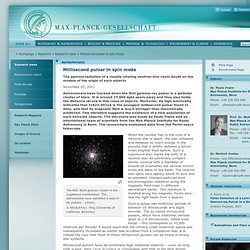
It is around 27,000 light years away and thus also holds the distance record in this class of objects. Moreover, its high luminosity indicates that J1823-3021A is the youngest millisecond pulsar found to date, and that its magnetic field is much stronger than theoretically predicted. 'Zombie' stars. "Zombie" stars that explode like bombs as they die, only to revive by sucking matter out of other stars.

According to an astrophysicist at UC Santa Barbara, this isn't the plot for the latest 3D blockbuster movie. Instead, it's something that happens every day in the universe - something that can be used to measure dark energy. “Impossible” Star Exists in Cosmic Forbidden Zone. Want to stay on top of all the space news? Follow @universetoday on Twitter This ancient star, in the constellation of Leo (The Lion), is called SDSS J102915+172927 and has been found to have the lowest amount of elements heavier than helium of all stars yet studied. It has a mass smaller than that of the Sun and is probably more than 13 billion years old. Credit: ESO/Digitized Sky Survey 2 Astronomers say a newly found star should not exist and is in the “forbidden zone” of a widely accepted theory of star formation.
“A widely accepted theory predicts that stars like this, with low mass and extremely low quantities of metals, shouldn’t exist because the clouds of material from which they formed could never have condensed,” said Elisabetta Caffau (Zentrum für Astronomie der Universität Heidelberg, Germany and Observatoire de Paris, France), lead author of the paper appearing in this week’s edition of Nature. Also very surprising was the lack of lithium in SDSS J102915+172927. Source: ESO. The star that should not exist. (PhysOrg.com) -- A team of European astronomers has used ESO’s Very Large Telescope (VLT) to track down a star in the Milky Way that many thought was impossible. They discovered that this star is composed almost entirely of hydrogen and helium, with only remarkably small amounts of other chemical elements in it. AAVSO (AAVSO) sur Twitter. American Association of Variable Star Observers. So you think you're big?
A supermassive star, all alone. A visible/infrared composite view of the Tarantula, with VFTS 682 at its centre. (Image: ESO/M. -R. Cioni/VISTA Magellanic Cloud survey. Acknowledgment: Cambridge Astronomical Survey Unit) The Tarantula Nebula is a gift that keeps on giving – if you’re into really massive stars, that is.
Quark Stars. Star Types ☆ Team Curated.